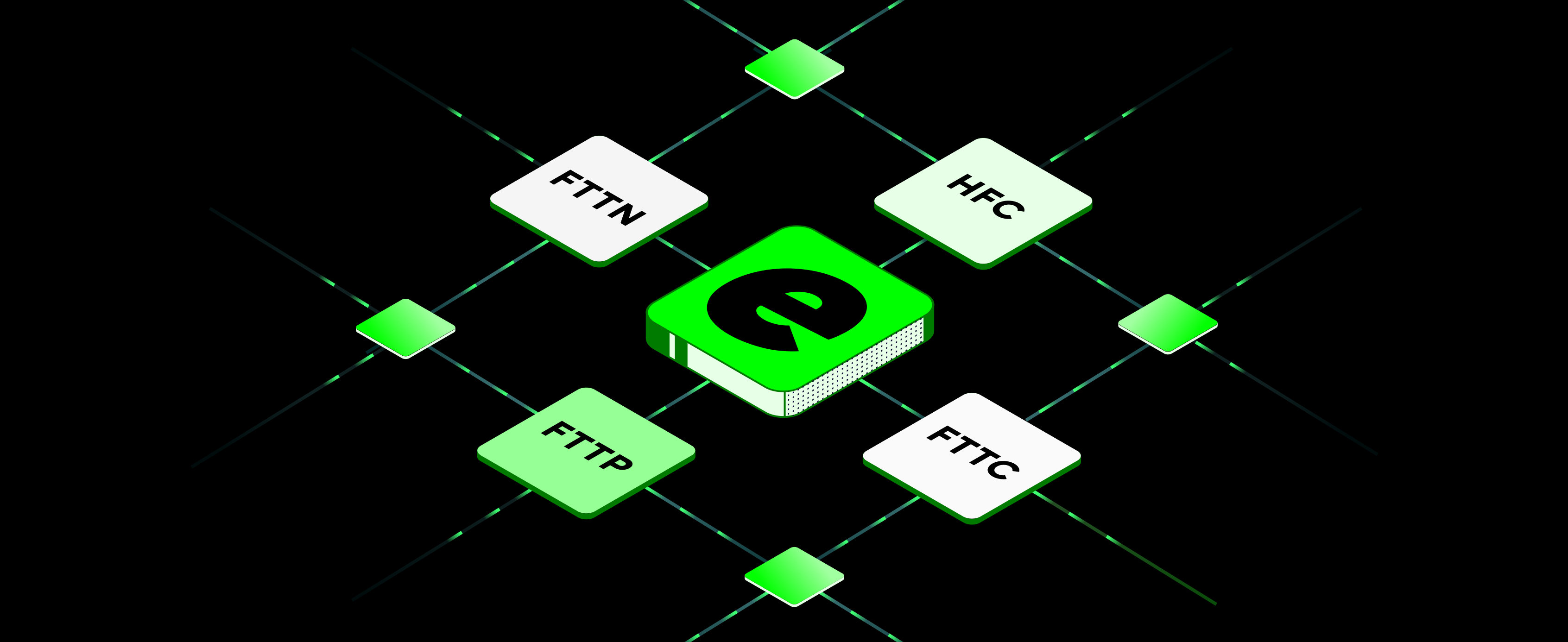Incompatible Devices - Emergency Calling (000) Update - more info here.
FTTP vs FTTC vs FTTN vs HFC
What are all these letters about? And what do they actually mean? We’ve thrown them in the ring for a battle royale—who’s gonna come out on top?

Introduction
The National Broadband Network (nbn) is a transformative initiative aimed at providing Australians with reliable, high-speed internet access. Designed to bridge the digital divide, the nbn offers various connection types to cater to different locations and needs.
However, the type of connection you receive can significantly affect your internet experience. This guide examines four key nbn technologies—Fibre to the Premises (FTTP), Fibre to the Node (FTTN), Fibre to the Curb (FTTC), and Hybrid Fibre Coaxial (HFC)—to help you understand their differences.
Throughout this article, we will also explore Exetel’s The One nbn plan, crafted for FTTP and HFC users, which offers innovative features tailored to modern internet demands.
Fibre to the Premises (FTTP)
FTTP delivers fibre optic cables directly to your property, ensuring a private and dedicated connection.
Technology: This method uses 100% fibre optic technology, enabling top-tier speeds and reliability.
Maximum Speed: FTTP offers speeds up to 1000Mbps (1Gbps), making it the fastest option available under the NBN.
Benefits
Exceptional Speed and Stability: FTTP is unmatched in terms of performance, offering smooth browsing, gaming, and streaming experiences.
Minimal Signal Loss: Its direct fibre connection ensures consistent speeds over long distances.
Future-Ready: With a lifespan of 20 to 40 years, FTTP is a long-term solution for evolving internet needs.
FTTP is ideal for heavy internet users and businesses requiring uninterrupted high-speed access. Its infrastructure supports multiple devices and intensive tasks like video conferencing and 8K streaming, ensuring seamless connectivity. Additionally, FTTP’s capacity for symmetrical upload and download speeds is a critical advantage for users who rely on cloud services, making it a standout choice for tech-forward households and enterprises.
Fibre to the Node (FTTN)
FTTN connects fibre cables to a node in your suburb, with existing copper lines completing the journey to your home.
Technology: A hybrid approach combining fibre optics and copper cabling.
Maximum Speed: Speeds typically range from 50Mbps to 100Mbps, influenced by the distance between your premises and the node.
Considerations
Distance Matters: The closer you are to the node, the better your speeds will be.
Quick Rollout: Utilising existing copper infrastructure makes FTTN faster to deploy.
FTTN is suitable for light internet users or those in areas where faster connections are not yet available. However, it’s prone to speed fluctuations, especially during peak times or in locations far from the node. Over time, the aging copper infrastructure requires maintenance or upgrades, further limiting its appeal to users seeking consistent high-speed access.
Fibre to the Curb (FTTC)
FTTC brings fibre optic cables to a distribution point near the property, with a short copper connection linking it to your premises.
Technology: A blend of fibre optic cabling and a brief copper extension.
Maximum Speed: FTTC offers improved speeds compared to FTTN but doesn’t reach the full potential of FTTP.
Advantages
Balanced Performance: FTTC strikes a compromise between cost and speed.
Stable Speeds: Offers more consistent connections than FTTN, thanks to reduced copper dependency.
FTTC is a practical option for households seeking better speeds than FTTN without the higher costs associated with FTTP. While not as sustainable, it delivers reliable performance for everyday internet activities. This connection type is particularly appealing for users in suburban areas where fibre-to-the-premises installation is not yet available, but the demand for better-than-average speeds exists.
Hybrid Fibre Coaxial (HFC)
HFC uses existing pay TV or cable TV infrastructure, combined with fibre optic technology, to deliver internet services.
Technology: A combination of fibre optics and coaxial cable ensures robust connectivity.
Maximum Speed: HFC supports speeds of 1000Mbps, making it competitive with FTTP.
Benefits
Broad Availability: Many urban areas already have HFC infrastructure, enabling faster deployment.
Continuous Upgrades: Ongoing enhancements improve network stability and speed.
Significant Improvement Over ADSL: HFC offers a reliable step up from older technologies.
HFC is a versatile option for suburban and urban users. It balances availability with performance, making it a solid choice for families and professionals. However, its speeds may vary slightly during peak periods due to shared network use. Recent developments in HFC technology, including the introduction of DOCSIS 3.1, have significantly boosted its capabilities, ensuring it remains a competitive option for high-speed internet users.
Comparison
Technology | Connection Method | Max Speed | Reliability | Deployment Speed |
FTTP | Fibre optic to premises | 1000 Mbps | High | Slower |
HFC | Fibre + coaxial cable | 1000 Mbps | Medium-High | Faster |
FTTC | Fibre to the curb, copper to premises | Better than FTTN | Medium | Moderate |
FTTN | Fibre to the node, copper to premises | 50-100 Mbps | Medium | Fast |
Speed Ranking: FTTP > HFC > FTTC > FTTN
Reliability and Upgradability: FTTP and HFC lead in future-proofing and consistent speeds.
Ease of Installation: FTTN and HFC benefit from leveraging existing infrastructure for faster rollouts.
Exetel The One nbn plan for FTTP and HFC
Exetel’s The One nbn plan is specifically designed for FTTP and HFC users, delivering maximum speed and reliability. Key Features:
Hibernate: Dial down your plan temporarily without losing your connection—perfect for part-time or seasonal users.
Warp Speed: Enjoy ultra-fast speeds ideal for high-definition streaming, gaming, and remote work.
Exetel stands out with its focus on customer satisfaction, competitive pricing, and advanced features. The One nbn plan ensures minimal downtime and stable performance, catering to modern internet needs.
Whether you’re a gamer, a professional working from home, or a family with high data demands, Exetel’s plan provides the speed and reliability you need.
Related Articles
© Copyright 2025 Exetel Pty Ltd. All rights reserved.


